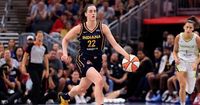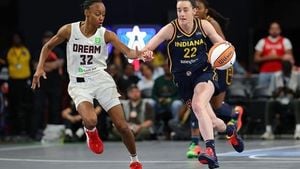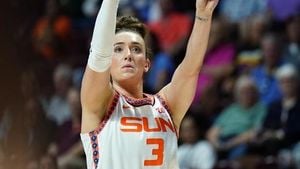On Tuesday night, the basketball world’s attention is glued to Las Vegas, where the Aces are set to host the Indiana Fever in a high-stakes, winner-take-all Game 5 of the WNBA semifinals. It’s a late-night showdown, tipping off at 9:30 p.m. ET on ESPN2, with the victor earning a coveted spot in the WNBA Finals against the Phoenix Mercury. The Finals, notably, are expanding to a seven-game series for the first time, signaling the league’s growing ambitions and popularity.
Even as the Fever take the court without their injured superstar, Caitlin Clark, the team’s postseason run has captured the nation’s imagination. Clark, sidelined since mid-July due to a groin injury and omitted from Indiana’s playoff roster, remains a central figure in the ongoing narrative of women’s basketball—both for her impact on the court and the ripple effects she’s created beyond it.
The numbers tell a compelling story. Despite Clark’s absence, Indiana has delivered blockbuster TV ratings throughout the postseason. Game 2 of the semifinals pulled in 1.7 million viewers on ESPN, good for the third-largest WNBA second-round playoff audience ever recorded. Game 1 wasn’t far behind, averaging 1.4 million viewers on ABC. Weekend ratings for Games 3 and 4 are still pending, but the Fever’s ability to draw eyeballs is undeniable. For a league that has fought for decades to expand its audience, these figures mark a watershed moment.
Yet, Tuesday’s decisive Game 5 finds itself on ESPN2, not the flagship ESPN channel. The reason? ESPN is airing MLB wild-card playoff games, while ABC sticks to its standard weeknight programming. It’s a classic case of competing sports priorities, and it raises a tantalizing what-if: Would a healthy Caitlin Clark have convinced ESPN to shuffle its lineup and give this semifinal the prime-time billing it arguably deserves? We’ll never know for sure, but the speculation lingers.
Regardless, the broadcasting landscape is about to change. This is the final season that ESPN/Disney holds exclusive rights to the WNBA playoffs. Beginning in 2026, a new $2.2 billion media-rights deal will see ESPN, NBC, and Amazon divvy up coverage, with the semifinals and Finals rotating among them for the next 11 years. NBC is even expected to take over MLB’s wild-card series, potentially freeing up ESPN for more women’s basketball coverage in the future. The league’s rising profile—and its stars’ undeniable drawing power—has forced the networks to take notice.
But as the WNBA enjoys this surge in visibility, storm clouds are gathering off the court. On September 30, Minnesota Lynx star and WNBPA vice president Napheesa Collier delivered a scathing critique of league leadership during exit interviews. According to ESPN’s Myron Medcalf, Collier accused WNBA Commissioner Cathy Engelbert of telling her, “only losers complain about officiating in the WNBA,” and making the eyebrow-raising assertion that Caitlin Clark “should be grateful for the WNBA because the league is responsible for her sponsorship deals.”
Collier’s remarks, prepared in advance, didn’t pull any punches. She lambasted the league for what she described as “the worst leadership in the world” and accused executives of failing to value the athletes who drive the WNBA’s product. These comments arrive at a pivotal moment, as the current collective bargaining agreement between the league and its players is set to expire at the end of October. The tension between players and league officials has been simmering for months, with salary structures and working conditions at the heart of ongoing negotiations.
Collier’s specific claim about Clark’s sponsorships struck a nerve in basketball circles. The 23-year-old Fever sensation entered the WNBA already a millionaire, thanks to name, image, and likeness (NIL) deals she secured during her collegiate career at Iowa. In 2024, ON3 reported that Clark’s NIL earnings totaled a staggering $3.1 million, ranking her fourth among all NIL-eligible athletes and first in women’s college basketball. While some endorsements may have anticipated her professional stardom, to suggest the WNBA alone is responsible for her commercial success is, as critics argue, a misreading of the modern athlete’s brand-building power.
Clark’s influence extends far beyond her scoring exploits. She’s shattered records at every level: all-time NCAA Division I scoring leader—across both men’s and women’s categories—most points and assists by a WNBA rookie, and the league’s first rookie to notch a triple-double. Her impact is also being felt in the sports collectibles market, where she’s become a phenomenon in her own right. In 2025, two of Clark’s trading cards smashed records for women’s sports cards, selling for $366,000 in March and a jaw-dropping $660,000 just four months later.
The surge in demand for Clark memorabilia has sparked a broader renaissance in women’s sports collectibles, particularly basketball cards. Professional Sports Authenticator (PSA) president Ryan Hoge told reporters, “It’s gone from nothing to a meaningful amount,” noting that Clark is now PSA’s second-most-graded basketball player this year, trailing only Michael Jordan. From January through September 2025, PSA graded nearly 159,000 WNBA cards—almost triple the previous year’s total.
The ripple effect is spreading to other WNBA stars. Paige Bueckers, Angel Reese, JuJu Watkins, and Cameron Brink have all seen dramatic increases in the number of their cards submitted for grading. Collectors are paying serious money, too: since April 1, 2025, at least 13 Bueckers cards have fetched over $10,000, and two Reese cards have topped $30,000 since late July. Even rookie cards for players like Cameron Brink are commanding five-figure sums. As Ron Jaiven, eBay’s general manager of U.S. collectibles, observed, “We’re seeing incredible increases this year even versus 2024. Caitlin Clark is certainly the biggest, but we’re seeing searches and sales for modern, even traditional players like Candace Parker and Sue Bird rookie cards.”
Industry insiders are watching closely to see if this collecting boom will spill over into other women’s sports, but for now, the WNBA is leading the charge. The league’s rising ratings, surging memorabilia market, and headline-grabbing stars are fueling optimism about the future—even as internal disputes threaten to disrupt the momentum.
For Clark, the Fever, and the Aces, Tuesday night’s Game 5 is about more than a trip to the Finals; it’s a showcase for a league in transition, grappling with both unprecedented opportunity and familiar challenges. The outcome remains uncertain, but one thing’s clear: women’s basketball is having its moment, and the world is watching.






